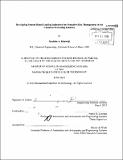Developing system-based leading indicators for proactive risk management in the chemical processing industry
Author(s)
Khawaji, Ibrahim A. (Ibrahim Abdullah)
DownloadFull printable version (12.08Mb)
Other Contributors
Massachusetts Institute of Technology. Engineering Systems Division.
Advisor
Nancy G. Leveson.
Terms of use
Metadata
Show full item recordAbstract
The chemical processing industry has faced challenges with achieving improvements in safety performance, and accidents continue to occur. When accidents occur, they usually have a confluence of multiple factors, suggesting that there are underlying complex systemic problems. Moreover, accident investigations often reveal that accidents were preventable and that many of the problems were known prior to those accidents, suggesting that there may have been early warning signs. System-based analysis addresses systemic aspects and leading indicators enable the detection of ineffective controls and degradation of the system. Together, they could enable taking needed actions before an incident or a loss event. To develop process safety indicators, the chemical processing industry currently uses guidelines that are mainly based on the concepts of the "Swiss Cheese Model" and the "Accident Pyramid." The current guidelines lack a systemic approach for developing process safety indicators; the guidelines view indicators as independent measures of the safety of a system (e.g. a failure of a barrier), which can be misleading because it would not identify ineffective controls, such as those associated with the migration of the system towards an unsafe state, or associated with interdependencies between barriers. Moreover, process safety indicators that are currently used in the chemical industry are more focused on lagging as opposed to leading indicators. This main objective of this thesis is to develop a structured system-based method that can assist a hydrocarbon/chemical processing organization in developing system-based process safety leading indicators. Building on developed safety control structures and the associated safety constraints, the proposed method can be used to develop both technical and organizational leading indicators based on the controls, feedbacks, and process models, which, ultimately, can ensure that there is an effective control structure.
Description
Thesis (S.M.)--Massachusetts Institute of Technology, Engineering Systems Division, 2012. Cataloged from PDF version of thesis. Includes bibliographical references (p. 78-80).
Date issued
2012Department
Massachusetts Institute of Technology. Engineering Systems DivisionPublisher
Massachusetts Institute of Technology
Keywords
Engineering Systems Division.